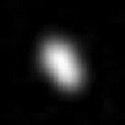Styx (księżyc)
 Zdjęcie Styx wykonane przez sondę New Horizons 13 lipca 2015 roku | |
| Odkrywca | Mark R. Showalter i inni (Kosmiczny Teleskop Hubble’a) |
|---|---|
| Data odkrycia | 26 czerwca 2012 |
| Charakterystyka orbity | |
| Półoś wielka | ~47×103 km |
| Mimośród | ~0 |
| Własności fizyczne | |
| Wymiary | 7×5 km[1] |

Styx (do lipca 2013 S/2012 (134340) 1, nieformalnie: P5 lub S/2012 P 1)[2] – naturalny satelita Plutona, odkryty na serii zdjęć wykonanych od 26 czerwca do 9 lipca 2012 przez Kosmiczny Teleskop Hubble’a[3]. 11 lipca 2012 roku ogłoszono, że zaobserwowany obiekt jest istotnie piątym znanym księżycem tej planety karłowatej[3]. O odkryciu poinformował Mark R. Showalter z SETI Institute[3].
Księżyc obiega Plutona po orbicie zbliżonej do okręgu o promieniu około 47 000 km wewnątrz orbity księżyca Nix, a na zewnątrz orbity Charona. Jest to najmniejszy znany obecnie księżyc Plutona, jego wymiary to ok. 7 km na 5 km[1].
Zobacz też
Przypisy
- ↑ a b Lillian Gipson: New Horizons Picks Up Styx. NASA. [dostęp 2015-10-10].
- ↑ MUA: Names for New Pluto Moons Accepted by the IAU After Public Vote. iau.org, 2013-07-02. [dostęp 2013-07-08]. (ang.).
- ↑ a b c Hubble Discovers a Fifth Moon Orbiting Pluto. HubbleSite News Center, 2012-07-11. [dostęp 2012-07-11]. (ang.).
Linki zewnętrzne
- Styx. [w:] Solar System Exploration [on-line]. NASA. [dostęp 2018-12-23]. (ang.).
Media użyte na tej stronie
This is a revised version of Solar_System_XXIX.png.
Image(s) of Styx taken by the Long Range Reconnaissance Imager (LORRI) on 13 July, approximately 12.5 hours before New Horizons’ closest approach to Pluto.
This image, taken by NASA's Hubble Space Telescope, shows five moons orbiting the distant, icy dwarf planet Pluto. The newly discovered small moon, Styx (initially designated P5), is the innermost of the moons found by Hubble over the past seven years. The diagram shows that Styx is in a 58,000-mile-diameter circular orbit around Pluto that is assumed to be co-planar with the other satellites in the system. Though Charon (discovered in 1978) is an even closer moon to Pluto, some astronomers consider the Pluto-Charon pair a "double planet" because Charon's mass is 12 percent of Pluto's mass (by comparison, our Moon is 1.2 percent Earth's mass). This image was taken with Hubble's Wide Field Camera 3 on July 7. Other observations that collectively show the moon's orbital motion were taken on June 26, 27, and 29, 2012 and July 9, 2012. The new data will help scientists in their planning for the July 2015 flyby of Pluto by NASA's New Horizons spacecraft.
The original NASA image has been modified by replacing "P4" and "P5" with newer designations "Kerberos" and "Styx", respectively.


